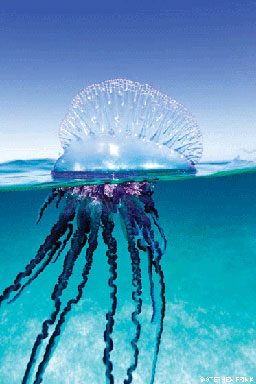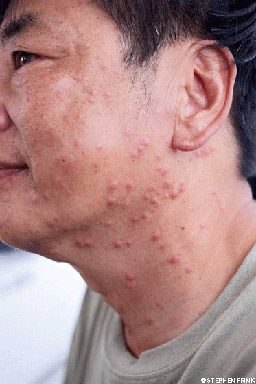Some of the most beautiful and seemingly harmless marine invertebrates are among the most hazardous. Snorkelers and divers may unintentionally come into contact with free-swimming jellyfish or touch hydrozoans such as fire coral while exploring reefs or wrecks. Occasionally, people may be stung while handling or stepping on jellyfish that have washed ashore. Although many envenomations are mild, some marine invertebrates produce incredibly potent toxins that can cause serious medical complications and even death.
General Treatment Principles
The four main classes considered in this article are (1) hydrozoans, such as Portuguese man-of-war and fire coral; (2) scyphozoans, the true jellyfish; (3) anthozoans, including stony corals, soft corals and anemones; and (4) cubozoans, the box jellyfish, including Chironex fleckeri. Each of these classes is armed with stinging cells generally known as nematocysts. Symptoms of envenomation depend on the species, venom dose and body location. Immediately after a suspected jellyfish or hydroid sting, rinse the affected area with household vinegar (acetic acid 5 percent solution). If vinegar is not available, use seawater or a paste of baking soda. Hot water (to the victim’s and caregiver’s tolerance), heat packs, cold packs or ice may provide some pain relief, but do not place ice or unheated freshwater directly on affected skin. Remove any tentacle fragments, but take care to avoid contact with fingers or hands (wear thick gloves if possible). Rinse again with any remaining vinegar.
Hydrocortisone (0.5 percent to 1 percent) cream or ointment may be applied twice daily to the affected area until signs and symptoms of envenomation disappear. In some cases, a doctor may need to prescribe a stronger steroid regimen. If the area appears infected or the victim develops a fever, discontinue the use of any steroid and seek medical care. Complex or significant envenomations (any producing systemic symptoms such as nausea, vomiting, shortness of breath or confusion) require immediate evaluation by a physician.
After an envenomation it is possible for individuals to develop an allergic reaction, which may be severe. Anaphylaxis is a potentially deadly allergic reaction that can involve respiratory distress, airway compromise and other unstable vital signs. If anaphylaxis occurs, immediately administer epinephrine with an EpiPen or Twinject auto injector, if available. Provide oxygen and the antihistamine diphenhydramine (Benadryl). All patients suspected of having a serious allergic reaction should be treated immediately by a physician, who may administer prednisone or other medications.
Safe Sea, a topical jellyfish-sting inhibitor, has been shown to effectively diminish or prevent certain jellyfish stings. Care should be taken when swimming or diving into jellyfish-infested waters. Protective clothing should be worn, and a wide berth should be given to all jellyfish because tentacles may trail for several meters behind the bell and main body of the organism. Gloves may help protect against hydroid and anemone stings.
Box Jellyfish Stings
The most well-known box jellyfish, Chironex fleckeri, is perhaps the most venomous creature in the sea and can cause death within minutes of envenomation. Although box jellyfish are most often found in quiet, protected and shallow areas — chiefly in the waters off northern Queensland, Australia — they may also be found in the open ocean. Death is attributed to shock, respiratory paralysis and subsequent cardiac arrest and may occur in 15-20 percent of cases. With any suspected box-jellyfish sting, the victim must be assessed rapidly for adequate breathing and supported as needed with artificial breathing and oxygen. The person should be moved as little as possible. The affected area should be immediately flooded with vinegar for at least 30 seconds and preferably a few minutes before any attempt is made to remove adherent tentacles; this can neutralize nematocysts somewhat and helps lessen the ultimate degree of envenomation. Severe pain and rapid development of wheals, blisters and reddish-purple tentacle markings are likely. In certain areas, such as Queensland, Australia, antivenin is available in hospitals and at some beaches, where lifeguards may be trained to administer it by intramuscular injection.

Portuguese Man-of-War
The Portuguese man-of-war (Physalia physalis), known in the Pacific as the bluebottle, is not a true jellyfish but a colony of organisms. The man-of-war floats in the open ocean, typically in warm waters without any means of propulsion, relying solely on currents and winds. Man-of-war stings usually cause severe pain, leaving whiplike red welts on the skin. Other reactions include fever, shock, cardiac and pulmonary failure and, in rare cases, death.
Although painful, man-of-war stings often resolve on their own. Affected areas should be rinsed with seawater (avoid freshwater). If symptoms persist, worsen or show no sign of improvement after several hours, or if there are any systemic symptoms such as fever, confusion, nausea or vomiting, seek care from a physician.
Fire Coral Sting
Fire corals are hydrozoans rather than true corals, although like corals, they are immobile. Fire corals have nematocysts but also have sharp edges that may cause lacerations or abrasions. Symptoms of fire-coral envenomation include immediate stinging and burning. A skin reaction, involving red wheals and blisters, may develop along with considerable itching. Fire-coral envenomations should be treated according to the general treatment principles described at the beginning of this article.

Seabather’s Eruption
Seabather’s eruption is a skin irritation, mostly of covered areas of the body, caused by larval forms of certain sea anemones. Skin manifestations of seabather’s eruption may occur minutes to hours after swimming. The reaction typically involves red, burning, itchy bumps and/or hives that may persist for up to two weeks. Treatment consists of washing the affected areas with soap and water followed by a vigorous rinse. An initial brief soak with vinegar may help reduce symptoms.
Jellyfish and hydroid envenomations are frequently painful and may occasionally cause severe illness. Careful employment of the techniques above, as well as an effective evacuation plan and knowledge of local medical facilities and resources (including the availability of antivenin) can reduce pain and may be lifesaving.
© Alert Diver — Q3 Summer 2011